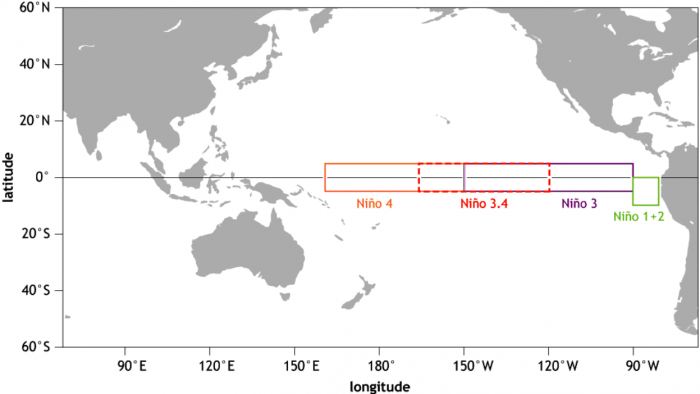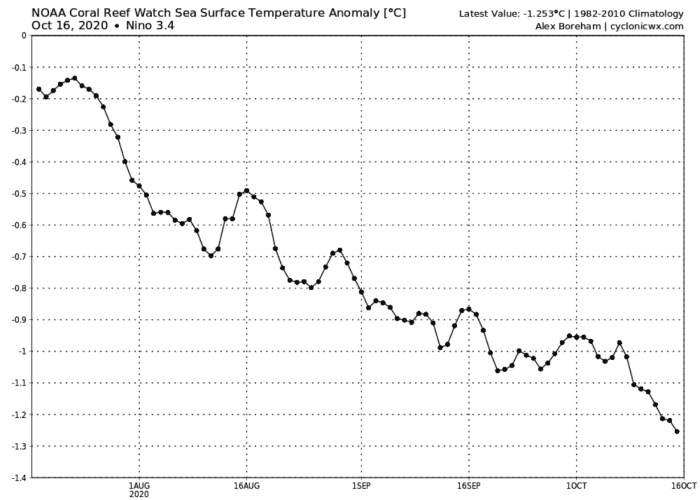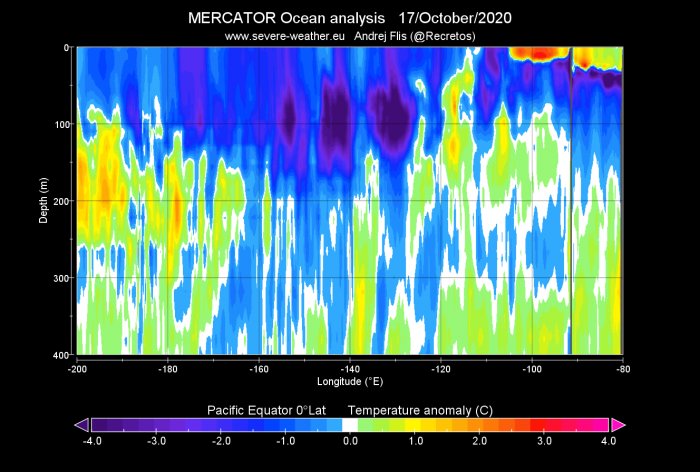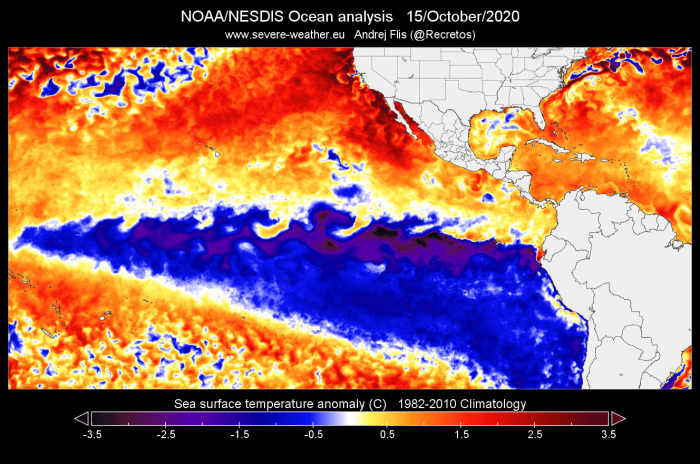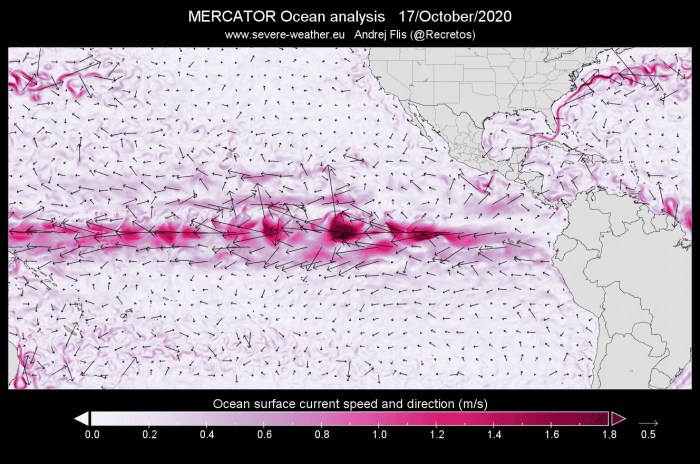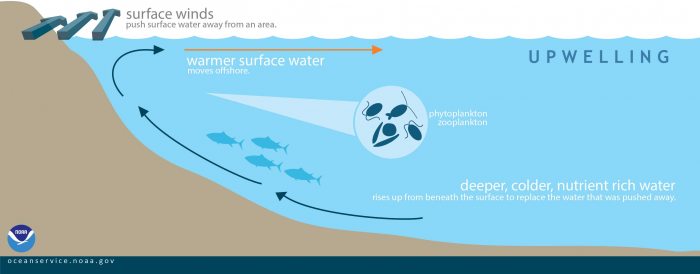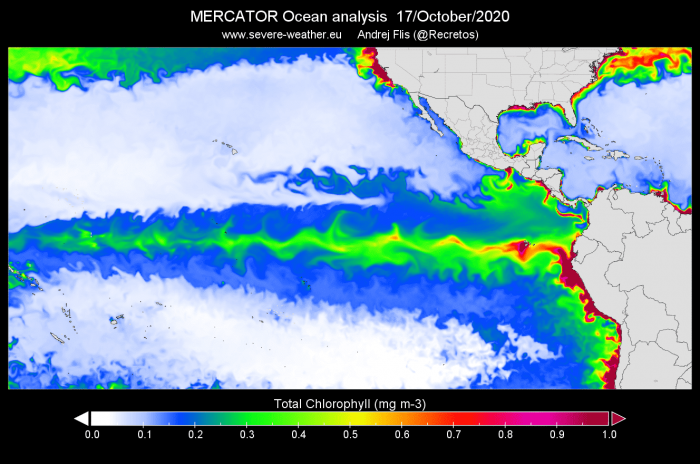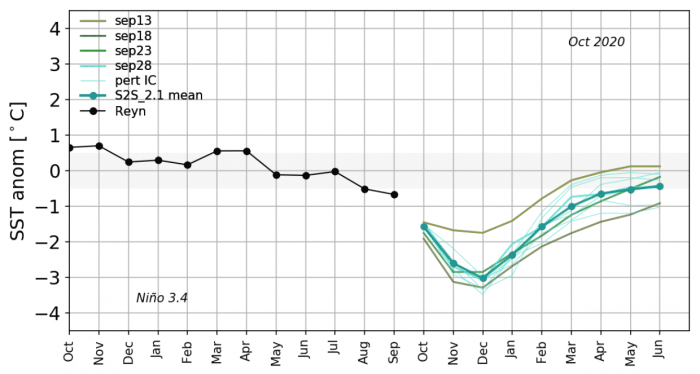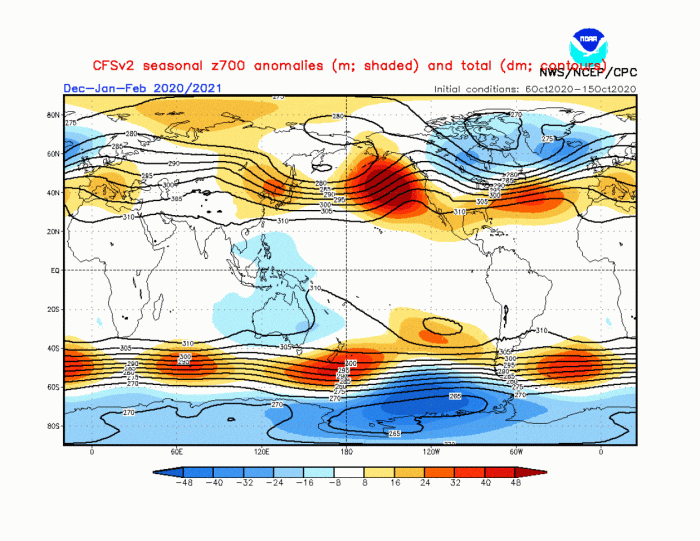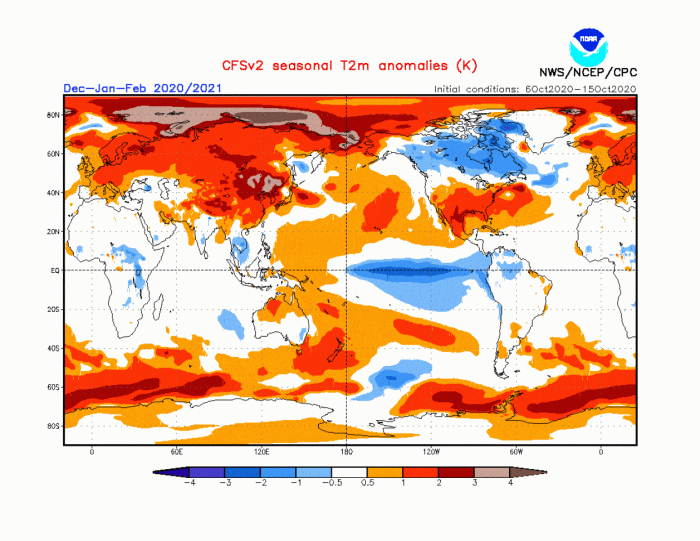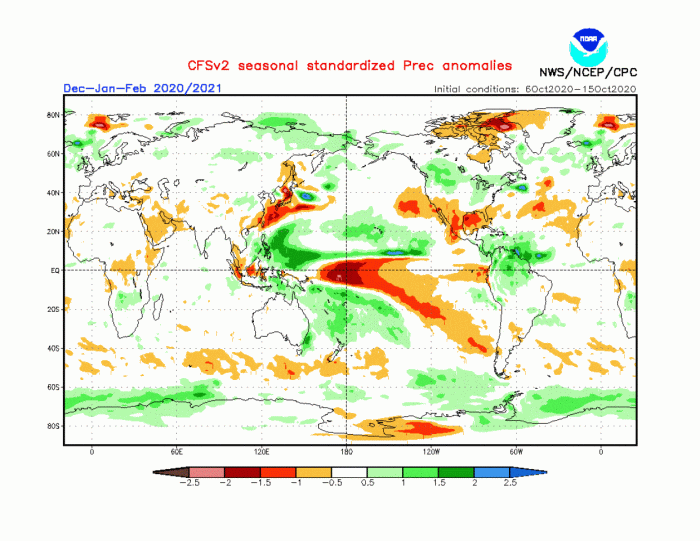La Nina is getting ready to take over Winter 2020/2021, cooling further across the equatorial Pacific Ocean. More oceanic cooling is expected towards winter, as easterly trade winds in the Pacific remain strong. But what is La Nina, and what does it have to do with Winter?
About 71 percent of the Earth’s surface is covered by water, with the oceans holding about 96.5 percent of all the Earth’s water. That is a very large area and the reason why oceans play a pivotal role in the global weather system.
We usually look at many different ocean areas across the world. But none is more famous and also influential, than the ENSO region in the tropical Pacific Ocean.
EL NINO SOUTHERN OSCILLATION – ENSO
To keep it as simple as possible, ENSO is short for “El Niño Southern Oscillation”. This is a region of ocean in the tropical Pacific, which is alternating between warm and cold phases.
ENSO has a major impact on the tropical convection patterns and the complex interaction of the ocean-atmosphere system, through which the ENSO influence is distributed globally. We can observe changes in large scale pressure patterns in the tropics and with some delay also in the rest of the world, as ENSO shifts between its phases.
The image below shows the ENSO regions in the tropical Pacific. The main regions are 3 and 4 and together cover a large part of the tropical Pacific. Most calculations and analysis is based on a combination of both regions, 3 and 4, seen on the image as the Nino 3.4 region. Region 3 covers the eastern tropical Pacific, while region 4 covers the central and western parts.
Each ENSO phase has a different effect on the weather in the tropics and the overall circulation and thus impacting the weather worldwide differently. A specific phase (cold/warm) usually develops in late summer and autumn and can last until next summer, or even up to two years in some cases.
The cold ENSO phase is called La Nina and the warm phase is called El Nino. The name La Nina literally translates to “the girl”, and the name El Nino translates to “the boy”, indicating an opposite relation between the phases. We determine the ENSO phase by the sea surface temperature anomalies (warmer/colder) in the ENSO 3.4 region in the tropical Pacific, which we showed above.
Current analysis reveals a quite extensive area of cooling in the tropical Pacific, extending almost across the entire equatorial Pacific area. Large areas are -2.5 to -3 degrees Celsius colder than normal. This is a pretty strong looking La Nina ENSO phase which continues to cool and strengthen. It is not yet designated as a strong event, as larger areas need to be even colder.
The cooling has been quite substantial and persistent over the past 3 months. The image below shows the sea surface temperature anomaly in the main ENSO 3.4 region. We can see a steady temperature drop, which is expected to continue.
Looking a bit deeper, at 50 meters below the surface, the anomalies are even stronger, with areas reaching below 4 degrees Celsius colder than normal. Also important to note, is the northeastern Pacific area and the west coast of the United States. Below the surface, the ocean here is not so abnormally warm as on the surface. That indicates the warm layer is quite superficial and could cool more rapidly with proper forcing.
The full vertical profile over the La Nina, reveals the ocean temperature anomaly by depth. We can see the strongest anomalies are found between 50 and 150 meters below the surface. This image shows a cross-section of sea temperature anomaly by depth along the equator in the Pacific Ocean, from the Asian side on the left to South America on the right.
LA NINA vs EL NINO
To fully understand the ENSO, we also have to look at its warm phase. Below we have two images of ocean temperature anomalies, one is the current La Nina in October 2020. The second is the strong El Nino event of the 2015/2016 cold season.
We can see a completely different picture, and two different phases over the same area of the ocean. Cooler than normal ocean temperatures during a La Nina, and warmer than average temperatures during an El Nino. As we will see later, their influence on the weather is also diametrically opposed.
But if we look at actual temperatures below, instead of the anomalies, we can also see a big difference in the temperature of the ocean surface. The first image shows the current sea surface temperatures in La Nina, and the second image shows the temperatures during the 2015/2016 El Nino event.
Obvious is the “cold tongue” of cooler ocean water during the La Nina, which creates these negative anomalies. The ocean temperature difference between the La Nina and El Nino can be quite large, up to 10 degrees celsius in some places
But what causes these cold and warm phases? There is no simple answer, but we can say that it is a result of the complex dynamic between pressure and winds. The tropical trade winds can usually initiate or stop a certain phase, as they mix the ocean surface and alter the ocean currents.
Basically, the trade winds are simple steady, and persistent winds, which blow towards (and along) the Equator in both Hemispheres. The image below from Weather.gov nicely shows a simplified version of the global prevailing winds. Trade winds are in yellow and red, depending on the Hemisphere.
When these easterly winds get stronger, they can actually start changing the ocean surface currents, and they can start pushing the water from east to west. The image below shows the ocean surface currents in the ENSO regions. We can see strong easterly currents, which are pushing the water towards the west. Notice the nicely seen Gulf Stream, running along the east coast of the United States, towards the northeast.
We can see these trade winds if we look at zonal wind anomalies over time. The image below shows the west-east movement of winds over the equator over time. The main ENSO regions are between 90W and 180W.
Positive zonal wind anomaly (red colors) mean weak easterly winds or even westerly winds. Negative zonal wind anomaly (blue colors) indicate stronger than normal easterly winds. We can obviously see for the past month, there were strong easterly winds present over the ENSO regions. That promoted persistent cooling and the forecast also indicates it to continue. The graphic is by Michael J. Ventrice.
Strong trade winds are important because they push the surface waters towards the west in the ENSO regions. The deeper and cooler water then rises up from beneath the surface to replace the water that was pushed away. This process is known as “upwelling.” Essentially this is a vertical transport process, as shown in the image below, which transports cooler waters to the surface.
Water that rises to the surface as a result of upwelling is typically colder and is quite rich in nutrients. These nutrients can “fertilize” the surface waters, meaning that these surface waters often have high biological productivity. We can track that by looking at the amount of chlorophyll (phytoplankton) in the ocean.
The comparison below shows the Chlorophyll concentrations in the current La Nina (first image) and during the same period in the 2015 El Nino event (second image). We can see that during La Nina, much more nutrients are available along the entire ENSO region, and also by the coastal areas of Middle and South America. This means more food is available for the fish, indicating a potentially good fishing season in the eastern equatorial Pacific.
We can nicely see this upwelling effect when looking at the temperature by depth across a La Nina and the El Nino. The first image below shows the 2020 La Nina and the second is the 2015/2016 El Nino event. Very obviously we can see the colder water is much closer to the surface over the eastern side in the La Nina, as it was raised towards the surface by the upwelling effect.
The best way to display the upwelling effect on the surface is with a high-resolution animation over time. The video below shows the large scale cooling in the tropical Pacific Ocean, as the La Nina emerged from below the surface. It nicely shows the strong east-to-west flow, powered by the strong trade winds, cooling the ocean as the colder water rises to the surface from the depths.
But the secret is not just in the winds themselves, as the pressure is also a key player. The ENSO phase directly responds to a special atmospheric pressure variability, called the Southern Oscillation Index.
The Southern Oscillation Index or SOI represents the difference in average air pressure measured at Tahiti (French Polynesia) and Darwin (Australia). The image below shows the location of the two pressure zones.
positive SOI values indicate that the pressure over the Tahiti side is higher than over Darwin in Australia. This corresponds to La Nina conditions. But during an El Nino, we see lower pressure in the eastern Pacific and over Tahiti, and higher over Darwin, Australia. This produces a negative SOI value.
We have the 30-day average SOI values on the image below, which show the increasing positive values and confirming the strengthening of the La Nina, and its growing influence. The SOI can be used to determine the potential effect or influence of the ENSO phase on the climate in the western Pacific and Australia.
STRONG, BUT GETTING STRONGER
We now know what ENSO is and what La Nina is. We can see that it is continuing to cool down and gaining strength. But how strong will it get?
Model forecasts indicate that La Nina will continue to grow in power towards early Winter 2020/2021. The image below is a model forecast from NASA-GMAO and suggests that unusually strong cooling would push this La Nina towards near-record strength (-3°C). Let’s keep in mind that La Nina is currently at around -1.3°C on average, so this forecast suggests more than twice cooler compared to now.
The image below is from the same forecast and shows the coldest La Nina conditions in November/December period. After that, it suggests the gradual weakening of La Nina. It even shows a warm ENSO phase (El Nino) starting to develop during Spring 2021.
A more conservative and perhaps more realistic forecast arrives from the Australian weather office (BOM). It shows the peak cooling of La Nina in December 2020, at around -2°C. This would mean a moderate to strong La Nina event. Gradual weakening during winter 2020/202 and into the Spring of 2021 is something that all forecasts generally agree on.
Ocean forecast from the ECMWF seasonal forecast system also shows a healthy and strong La Nina during the winter 2020/2021. It is perhaps weaker than the previous two forecasts, but has a very impressive looking La Nina event, extending the entire tropical pacific, from the Americas to Australia, covering 1/3rd of the Earth’s circumference.
But how exactly will this La Nina influence our winter weather? Glad you are interested…
WINTER IN THE GRIP OF THE LA NINA
At this point, we have to add, that an ENSO phase is not just a pure “influencer” only for our weather. It can also be viewed/interpreted as somewhat of a response to the overall global state of the atmosphere. Almost like a “warning light” on the dashboard of a car. But generally, ENSO does indicate an important influence on the Jet stream in the Pacific Ocean, and consequently also around the world
The jet stream is a large and powerful stream of air (wind) at around 8-11km (5-7mi) altitude. It flows west-to-east around the entire hemisphere, affecting the pressure systems, their strength, and thus shaping our weather at the surface.
Below is an example of the west to east flow during the winter of 2019/2020. Yellow-red areas show stronger westerly flow (the jet stream) at the 250mb level (~10.5km / 6.5mi). We can see that the strongest jet stream was positioned over the North Atlantic, extending directly over the British Isles and into Scandinavia. The Pacific part of the jet stream was weaker and confined more to the ocean.
Comparing the two phases of the ENSO, we can see that they can produce an entirely different weather pattern across North America, as it has a major influence on the Pacific polar jet stream. La Nina features a stronger and extended polar jet stream from Alaska and western Canada into the United States. While the El Nino features a stronger Pacific jet stream and an amplified storm track over the southern United States.
Looking closer at La Nina, we can see that the main feature is the strong and persistent high-pressure system in the North Pacific. It bends the jet from northwest to the southeast, creating a dipole pattern over the United States. Alaska, western Canada, and the northern United States usually experience colder than normal winter, with more precipitation. Southwest and the southern United States usually experience warmer and a bit drier conditions during La Nina winters.
The shifted jet stream also means a different snowfall potential. The colder air is more easily accessible to the northern United States, which also shows to have an increased snowfall potential during La Nina years. Especially areas like Alaska, Canada, and the northwest United States benefit from the northerly jet stream to produce more snowfall. The graphic is by NOAA-Climate.
Looking at the Winter 2020/2021 model forecast from the American CFSv2 model, we can see a typical La Nina weather pattern. The high pressure in the North Pacific, and a vast low-pressure system over Canada and into the North Atlantic. This is a typical jet stream “bending” pattern over North America, as the jet stream flows between the high and the low-pressure systems. We also see an amplified jet stream over northern Europe across the British Isles and into Scandinavia.
The temperature forecast for Winter 2020/2021 shows the resulting cooling from the northerly jet stream over Canada and the northern United States. The potential is there for the colder anomaly to expand further south, but a lot still depends on the development of the high-pressure system in the North Pacific. Europe also looks warmer than average with a mild winter generally. That is a result of the strong North Atlantic jet stream, preventing frequent drops of colder air into the continent.
Precipitation anomalies are also a more classical La Nina pattern. We see wetter than normal over the northern and eastern United States and drier over the southwestern and southern United States. We can also see wetter and more unsettled conditions over northern Europe, due to the strong North Atlantic jet stream, driving most storms over this region, causing more precipitation.
This is just a brief overview of one model solution. We will produce a more in-depth look at the latest (and final) model forecasts in the first half of November 2020, when the state of La Nina will be even better known.
Thinking of a nice Christmas gift for your friends, family or someone special to you? Weather calendar could be the perfect gift for them – see below:
